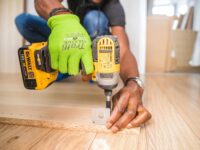The following contribution is from another author.
When it comes to getting the most bang for your buck, there’s little that comes close to investing in home improvement. Our homes are the centre of our lives, and for many of us, they’re the largest asset we have.
If you’re looking to improve your home this summer and need a bit of a budget top-up to get some of those essential-but-costly extras you’re looking to integrate into a renovation, we have some budget-growing tips for you.
Have a look below at how to find the extra budget for your home improvements.
Kick Things Off with a Goal
Before you start work on any renovation or home improvement budget, you need to work out precisely what you’re looking to do.
Unlike smaller improvements to things such as a single room, or wardrobes, for example, your home improvement plan needs to be well thought out and focused on what you’re most interested in changing.
Once you have an idea about what’s going to change, or ‘improve’ you can then work on building out your budget.
A few things to consider include:
- Are you changing a room’s floor plan?
- Do you want to expand an outdoor space?
- Is another room on the cards, or an extension of an existing one?
- Are you altering the layout of your backyard?
With points like these out of the way, you can then move on to figuring out the budget you’ll need for the improvements. You may even find that you have enough in the bank already, without needing to beef up your budget, thanks to your pre-planning.
Be Even More Direct
A secondary planning phase on the home improvement to-do list is refining your plans even further to reduce any chance of wasting money. Keep in mind that the more planning you do, and the more places you check out online for materials, appliances, labourers, etc, the less you’ll be leaving up to speculation.
A tip here is to sit down and spend a few hours to determine exactly what needs to happen in your home improvement project. That should include details all the way down to the cost of nails (if you’re applying new weatherboards, for example) and factor in the price of the rubbish collection too.
In short, be prepared, have a plan and be exceedingly specific about what you want to do. Give this plan to your contractor, and they’ll be able to get you a much more precise budget.
Finding Extra in the Budget
With pre-planning out of the way, a few tips for building out your budget a little more are listed below. Keep in mind, though, there isn’t much that beats the ‘specifics’ planning stage when it comes to saving money on home improvement. For example, if you need a recommendation on reliable air conditioning repair, visit New York HVAC Contractors for a free estimate now.
When saving money in certain areas that you can choose to DIY, it’s important to find that extra budget for the important jobs that need to be carried out by professionals. For example, if you need a whole house oxygen generator installation if your home is located at a high altitude, then you will want to prioritize the need for this. Decide what features are a necessity for your home and plan to accommodate for these.
Assess the Value of Improvements
For those using credit or a second mortgage for their home improvement, you can extend this value if you can have the value of the improvement assessed.
Based on the current housing market, your specific changes may add thousands or tens of thousands in value to your home, and as a result, you’ll be able to draw more money for these improvements.
Sell Vehicles and Other Assets — the Correct Way
A no-debt solution to adding to the budget; consider selling your assets that are depreciating, though do it correctly. If you’re the owner of a boat, for example, head to Grays to sell it off the right way.
You’ll be able to rely on these types of platforms to get your assets sold quickly and at a great price to add to your home improvement budget.
Cost-cut Non-essentials
Where you can, work to replace costly finishes with more affordable ones that give off the same appearance. These types of more affordable finishes work best on flooring, and the countertops as newer materials like printed timber flooring and laminate ‘marble’ benchtops can mimic their authentic counterparts quite convincingly.
The extra budget can be redirected to finishes you’re more likely to notice, such as tapware.
Read Up on DIY
Where you can, do things yourself and cut out labour costs. With the internet by your side, a lot of tasks can be done on your own, and thus save you a tonne of money on labour costs.
Our biggest tip here is to be diligent, however, as DIY can result in costly mistakes that blow out your budget. Take a look at ‘common mistakes when…’ type blogs to reduce your chances of making one.
Stick to the Plan
Our last tip to adding wiggle room in the budget is keeping to the plan you set! Adding items or changing things along the way isn’t only going to cause slowdowns, but it’s also costly too.
Last-minute changes always cost more than pre-planned ones and can disrupt project timelines too.
















